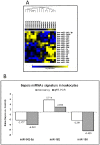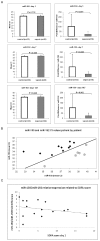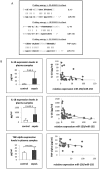MicroRNA fingerprints identify miR-150 as a plasma prognostic marker in patients with sepsis
- PMID: 19823581
- PMCID: PMC2756627
- DOI: 10.1371/journal.pone.0007405
MicroRNA fingerprints identify miR-150 as a plasma prognostic marker in patients with sepsis
Abstract
Background: The physiopathology of sepsis continues to be poorly understood, and despite recent advances in its management, sepsis is still a life-threatening condition with a poor outcome. If new diagnostic markers related to sepsis pathogenesis will be identified, new specific therapies might be developed and mortality reduced. Small regulatory non-coding RNAs, microRNAs (miRNAs), were recently linked to various diseases; the aim of our prospective study was to identify miRNAs that can differentiate patients with early-stage sepsis from healthy controls and to determine if miRNA levels correlate with the severity assessed by the Sequential Organ Failure Assessment (SOFA) score.
Methodology/principal findings: By using genome-wide miRNA profiling by microarray in peripheral blood leukocytes, we found that miR-150, miR-182, miR-342-5p, and miR-486 expression profiles differentiated sepsis patients from healthy controls. We also proved by quantitative reverse transcription-polymerase chain reaction that miR-150 levels were significantly reduced in plasma samples of sepsis patients and correlated with the level of disease severity measured by the SOFA score, but were independent of the white blood counts (WBC). We found that plasma levels of tumor necrosis factor alpha, interleukin-10, and interleukin-18, all genes with sequence complementarity to miR-150, were negatively correlated with the plasma levels of this miRNA. Furthermore, we identified that the plasma levels ratio for miR-150/interleukin-18 can be used for assessing the severity of the sepsis.
Conclusions/significance: We propose that miR-150 levels in both leukocytes and plasma correlate with the aggressiveness of sepsis and can be used as a marker of early sepsis. Furthermore, we envision miR-150 restoration as a future therapeutic option in sepsis patients.
Conflict of interest statement
Figures




References
-
- Hotchkiss RS, Karl IE. The pathophysiology and treatment of sepsis. N Engl J Med. 2003;348:138–150. - PubMed
-
- Bone RC, Balk RA, Cerra FB, Dellinger RP, Fein AM, et al. Definitions for sepsis and organ failure and guidelines for the use of innovative therapies in sepsis. The ACCP/SCCM Consensus Conference Committee. American College of Chest Physicians/Society of Critical Care Medicine. Chest. 1992;101:1644–1655. - PubMed
-
- Dombrovskiy VY, Martin AA, Sunderram J, Paz HL. Rapid increase in hospitalization and DEADality rates for severe sepsis in the United States: a trend analysis from 1993 to 2003. Crit Care Med. 2003;35:1244–50. - PubMed
-
- Hutchins RR, Gunning PM, Lucas DN, Allen-Mersh TG, Soni NC. Relaparotomy for suspected intraperitoneal sepsis after abdominal surgery. World J Surg. 2004;28:137–141. - PubMed
-
- Lichtenstern C, Schmidt J, Knaebel HP, Martin E, Büchler MW, et al. Postoperative Bacterial/Fungal Infections: A Challenging Problem in Critically Ill Patients after Abdominal Surgery. Dig Surg. 2007;24:1–11. - PubMed
Publication types
MeSH terms
Substances
LinkOut - more resources
Full Text Sources
Other Literature Sources
Medical

